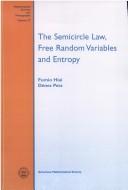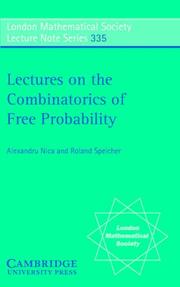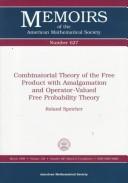| Listing 1 - 6 of 6 |
Sort by
|

ISBN: 0821820818 Year: 2000 Publisher: Providence (R.I.): American Mathematical Society
Abstract | Keywords | Export | Availability | Bookmark
 Loading...
Loading...Choose an application
- Reference Manager
- EndNote
- RefWorks (Direct export to RefWorks)

ISBN: 9780511735127 051173512X 9780521858526 0521858526 9781107368088 1107368081 9781107363168 1107363160 1139883291 1107372593 1107368391 1299405657 1107365627 0511893892 Year: 2006 Publisher: Cambridge Cambridge University Press
Abstract | Keywords | Export | Availability | Bookmark
 Loading...
Loading...Choose an application
- Reference Manager
- EndNote
- RefWorks (Direct export to RefWorks)
Free Probability Theory studies a special class of 'noncommutative'random variables, which appear in the context of operators on Hilbert spaces and in one of the large random matrices. Since its emergence in the 1980s, free probability has evolved into an established field of mathematics with strong connections to other mathematical areas, such as operator algebras, classical probability theory, random matrices, combinatorics, representation theory of symmetric groups. Free probability also connects to more applied scientific fields, such as wireless communication in electrical engineering. This 2006 book gives a self-contained and comprehensive introduction to free probability theory which has its main focus on the combinatorial aspects. The volume is designed so that it can be used as a text for an introductory course (on an advanced undergraduate or beginning graduate level), and is also well-suited for the individual study of free probability.
Combinatorial analysis. --- Free probability theory. --- Probability theory, Free --- Operator algebras --- Selfadjoint operators --- Combinatorics --- Algebra --- Mathematical analysis

ISSN: 00659266 ISBN: 0821806939 Year: 1998 Publisher: Providence (R.I.): American Mathematical Society
Abstract | Keywords | Export | Availability | Bookmark
 Loading...
Loading...Choose an application
- Reference Manager
- EndNote
- RefWorks (Direct export to RefWorks)
Probability theory --- Operator-valued functions. --- Selfadjoint operators. --- Free products (Group theory) --- Combinatorial analysis. --- Free probability theory. --- Fonctions à valeurs opératorielles. --- Opérateurs auto-adjoints. --- Produits libres (théorie des groupes) --- Analyse combinatoire. --- Combinatorial analysis --- Free probability theory --- Operator-valued functions --- Selfadjoint operators --- Operators, Selfadjoint --- Self-adjoint operators --- Linear operators --- Operator functions --- Functional analysis --- Products, Free (Group theory) --- Group theory --- Probability theory, Free --- Operator algebras --- Combinatorics --- Algebra --- Mathematical analysis
Book
ISBN: 1493969420 1493969412 Year: 2017 Publisher: New York, NY : Springer New York : Imprint: Springer,
Abstract | Keywords | Export | Availability | Bookmark
 Loading...
Loading...Choose an application
- Reference Manager
- EndNote
- RefWorks (Direct export to RefWorks)
This volume opens the world of free probability to a wide variety of readers. From its roots in the theory of operator algebras, free probability has intertwined with non-crossing partitions, random matrices, applications in wireless communications, representation theory of large groups, quantum groups, the invariant subspace problem, large deviations, subfactors, and beyond. This book puts a special emphasis on the relation of free probability to random matrices, but also touches upon the operator algebraic, combinatorial, and analytic aspects of the theory. The book serves as a combination textbook/research monograph, with self-contained chapters, exercises scattered throughout the text, and coverage of important ongoing progress of the theory. It will appeal to graduate students and all mathematicians interested in random matrices and free probability from the point of view of operator algebras, combinatorics, analytic functions, or applications in engineering and statistical physics.
Mathematics. --- Functional analysis. --- Probabilities. --- Probability Theory and Stochastic Processes. --- Functional Analysis. --- Distribution (Probability theory. --- Functional calculus --- Calculus of variations --- Functional equations --- Integral equations --- Distribution functions --- Frequency distribution --- Characteristic functions --- Probabilities --- Free probability theory. --- Random matrices. --- Matrices, Random --- Matrices --- Probability theory, Free --- Operator algebras --- Selfadjoint operators --- Probability --- Statistical inference --- Combinations --- Mathematics --- Chance --- Least squares --- Mathematical statistics --- Risk
Book
ISBN: 303480220X 3034807899 3034802218 1280398884 9786613576804 Year: 2012 Publisher: New York : Springer,
Abstract | Keywords | Export | Availability | Bookmark
 Loading...
Loading...Choose an application
- Reference Manager
- EndNote
- RefWorks (Direct export to RefWorks)
This book is dedicated to the memory of Israel Gohberg (1928–2009) – one of the great mathematicians of our time – who inspired innumerable fellow mathematicians and directed many students. The volume reflects the wide spectrum of Gohberg’s mathematical interests. It consists of more than 25 invited and peer-reviewed original research papers written by his former students, co-authors and friends. Included are contributions to single and multivariable operator theory, commutative and non-commutative Banach algebra theory, the theory of matrix polynomials and analytic vector-valued functions, several variable complex function theory, and the theory of structured matrices and operators. Also treated are canonical differential systems, interpolation, completion and extension problems, numerical linear algebra and mathematical systems theory.
Operator theory. --- Operator theory --- Selfadjoint operators --- Free probability theory --- Operator algebras --- Functional analysis --- Differential equations, Partial --- Mathematics --- Physical Sciences & Mathematics --- Calculus --- Mathematics. --- Matrix theory. --- Algebra. --- Functional analysis. --- Functions of complex variables. --- System theory. --- Operator Theory. --- Functional Analysis. --- Several Complex Variables and Analytic Spaces. --- Linear and Multilinear Algebras, Matrix Theory. --- Systems Theory, Control. --- Differential equations, partial. --- Systems theory. --- Partial differential equations --- Functional calculus --- Calculus of variations --- Functional equations --- Integral equations --- Systems, Theory of --- Systems science --- Science --- Mathematical analysis --- Complex variables --- Elliptic functions --- Functions of real variables --- Philosophy --- Gohberg, I. --- Gohberg, I. C., --- Gochberg, I. Z., --- Gokhberg, Izrailʹ T︠S︡udikovich. --- Gohberg, Israel, --- Gokhberg, Izrailʹ T︠S︡udikovich, --- Gokhberg, Yiśraʼel, --- Gokhberg, I. T︠S︡.
Book
ISBN: 0387878564 9786612973581 1282973584 0387878572 9780387878560 Year: 2011 Publisher: New York : Springer,
Abstract | Keywords | Export | Availability | Bookmark
 Loading...
Loading...Choose an application
- Reference Manager
- EndNote
- RefWorks (Direct export to RefWorks)
This study aims to embed the history of the central limit theorem within the history of the development of probability theory from its classical to its modern shape, and, more generally, within the corresponding development of mathematics. The history of the central limit theorem is not only expressed in light of "technical" achievement, but is also tied to the intellectual scope of its advancement. The history starts with Laplace's 1810 approximation to distributions of linear combinations of large numbers of independent random variables and its modifications by Poisson, Dirichlet, and Cauchy, and it proceeds up to the discussion of limit theorems in metric spaces by Donsker and Mourier around 1950. This self-contained exposition additionally describes the historical development of analytical probability theory and its tools, such as characteristic functions or moments. The importance of historical connections between the history of analysis and the history of probability theory is demonstrated in great detail. With a thorough discussion of mathematical concepts and ideas of proofs, the reader will be able to understand the mathematical details in light of contemporary development. Special terminology and notations of probability and statistics are used in a modest way and explained in historical context.
Central limit theorem -- History. --- Central limit theorem --- Mathematics --- Physical Sciences & Mathematics --- Mathematical Statistics --- History --- Central limit theorem. --- Free probability theory. --- Probability theory, Free --- Mathematics. --- History. --- Probabilities. --- Statistics. --- History of Mathematical Sciences. --- Probability Theory and Stochastic Processes. --- Statistics, general. --- Asymptotic distribution (Probability theory) --- Limit theorems (Probability theory) --- Operator algebras --- Selfadjoint operators --- Distribution (Probability theory. --- Statistical analysis --- Statistical data --- Statistical methods --- Statistical science --- Econometrics --- Distribution functions --- Frequency distribution --- Characteristic functions --- Probabilities --- Statistics . --- Probability --- Statistical inference --- Combinations --- Chance --- Least squares --- Mathematical statistics --- Risk --- Annals --- Auxiliary sciences of history --- Math --- Science --- Mathematics - History --- Distribution (Probability theory) --- Statistics
| Listing 1 - 6 of 6 |
Sort by
|

 Search
Search Feedback
Feedback About UniCat
About UniCat  Help
Help News
News